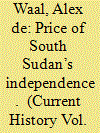|
|
|
Sort Order |
|
|
|
Items / Page
|
|
|
|
|
|
|
| Srl | Item |
| 1 |
ID:
085991


|
|
|
|
|
| Publication |
2008.
|
| Summary/Abstract |
Between 22 April and 6 May 2008, Sudan's fifth population and housing census was conducted in both North and South Sudan. Because it will have a decisive impact on future power and wealth sharing in Sudan, the census has been highly contested, and its outcome is likely to be controversial. Will the census enhance future stability in the Sudan? Or will it turn out to be a stumbling block and cause for further conflicts?
This briefing argues that the hotly contested census not only highlighted existing tensions between the North and the South on topics such as resources, power sharing, and identity but also intensified competition among Southern Sudanese political actors. The census, an immense logistical undertaking, mobilized the major political actors who seek to use it instrumentally in their own interest. It also created high expectations among the population about the future provision of services and development.
Under the provisions of the 2005 Comprehensive Peace Agreement (CPA) signed between the Sudan People's Liberation Movement/Sudan People's Liberation Army (SPLM/A) of Southern Sudan and the (Northern) National Congress Party (NCP), the census is supposed to pave the way for the planned 2009 general elections as well as the referendum in 2011 in which Southerners will decide about independence from the rest of Sudan.
In 2005, after 21 years of war between the North and the South, the two main parties in the conflict - the SPLM/A and NCP - signed the CPA, which ended armed hostilities. The vision of then SPLM/A rebel leader John Garang, who died in a helicopter crash a few months after the signing, was not an independent South, but a united 'New Sudan'. In terms of the CPA's power-sharing agreement, the SPLM, the political wing of the SPLA, became a partner of the NCP at the national level in the Government of National Unity (GoNU). In the South, the SPLM dominates the autonomous Government of Southern Sudan (GoSS), which was established with independent executive, legislative, and judiciary bodies based on the CPA.
|
|
|
|
|
|
|
|
|
|
|
|
|
|
|
|
| 2 |
ID:
138406


|
|
|
|
|
| Summary/Abstract |
When they celebrated independence on July 9, 2011, the people of South Sudan hoped that the fundamental problems that had doomed the united nation of Sudan over the previous 55 years had finally been resolved. At long last, as citizens of their own independent sovereign nation, South Sudanese would no longer be a minority subject to racial and religious discrimination, and robbed of their immense natural resources—water, farmland, and oil—by northern compatriots, who often bore a greater resemblance to colonizers than fellow citizens.
|
|
|
|
|
|
|
|
|
|
|
|
|
|
|
|
|
|
|
|
|